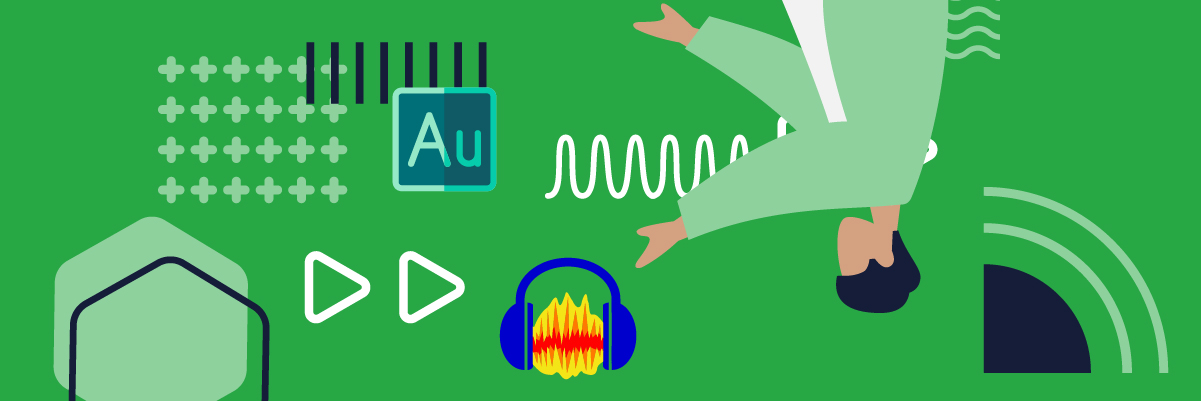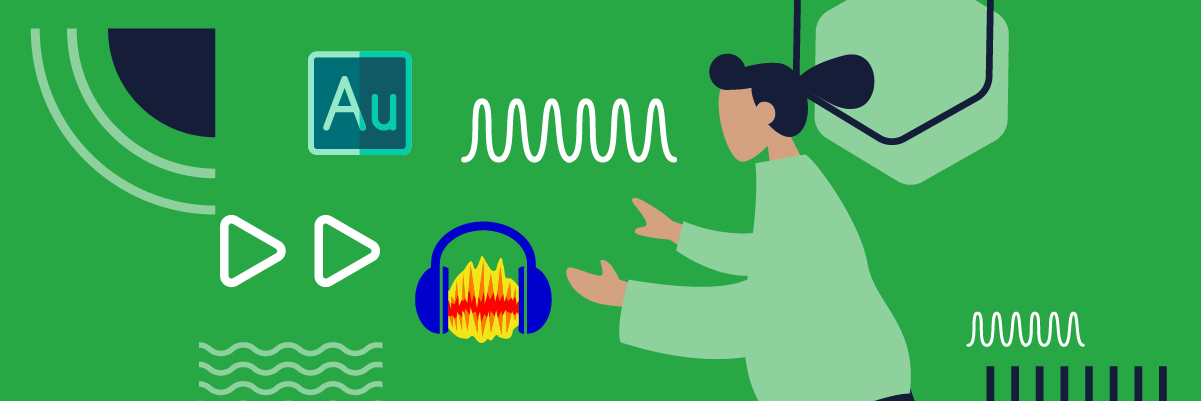Tech is advanced. So futuristic that many times it’s often a question of comparison. For podcasters, the contest often revolves around Adobe Audition Vs. Audacity.
Which way to go? How much do they cost? Is one better than the other? And which one should you use to capture your shows?
Indeed, we’re honored to live in the digital era where you can express what you think or feel in many ways. One of the most-used avenues to continue this chain of ideas is via a podcast show. Such periodic audio records make it easy for customers worldwide to download or consume audio shows online.
Using the right tools for the job is essential in ensuring quality results. However, mostly the show makers understand the pain of capturing voices, editing, and mixing into something the audience can consume. Luckily, wannabe podcasters have troves of tools—from software to hardware. Two widely-used recording software are
(1) Adobe Audition CC
(2) Audacity.
These are software-based digital audio workstations (DAWs) that allow you to edit, mix & produce audio files. DAWs come in multiple forms, from a single application software program on a PC or separate integrated unit to complex components running by a central control unit.
Learn everything about Audacity Vs. Audition below.
At a glance;
- What are Digital Audio Workstations
- Comparing Audacity vs. Audition
- How much do they cost?
- What’s the podcast process?
- Interface & Usability
- Multitracking features
- Mixing and Editing
- Limiting and Normalization
- Equalization
- Noise Reduction
- Audacity Vs. Audition: Which Way to Go?
Adobe Audition Vs. Audacity: Digital Audio Workstations
Audacity and Adobe Audition are arguably the most-used Digital Audio Workstations among podcasters.
A digital audio workstation (DAW) is an electronic gadget or software that you can use to edit, mix and produce audio files. They come in multiple forms, from a single application software program on a PC or a separate integrated unit to intricately-configured components run by a central control unit.
Whatever the setup, DAWs have an interface that podcasters can use to mix and edit many recordings into a single final track. These Digital Audio Workstations (DAW) are helpful in all aspects of podcast creation.
Suppose you are stuck between Audacity Vs. Audition; it’s better to master one instead of trying to switch between multiple software.
This discussion will help you learn the underlying differences between Adobe audition Vs. Audacity. Familiarizing yourself with these discrepancies can help you make an informed decision. It also enables you to choose software that matches your content needs.
To set the record straight, both software are unique and adequately designed for recording purposes. Like any other tool, each also has its share of downsides.

Comparing Adobe Audition Vs. Audacity
Affordability, usability, a rich cache of audio-cleaning features, and easy access to the final product are primary considerations for all podcasters.
Using the right tool for your unique job is essential in ensuring quality results.
But how do you know which tool fits your needs? By understanding how each application works and its features.
Learn all the crucial facts about Audacity Vs. Audition here:
1. How much do they cost?
Audacity is a free-to-use digital audio workstation, while Adobe Audition works entirely on per-month or-year subscriptions.
Still, you can test Audition’s free trial before buying a subscription. Its monthly plan costs $29.99, whereas the yearly plan winds up to $19.99 per month.
Tip: instead of buying this separately, you can subscribe to Adobe’s All Apps offer to enjoy multiple tools for $74.99/month or $49.99 per annual plan.
2. The Podcast Process
Nothing can be as discouraging for podcast makers as losing everything when you are about to conclude it. Thus, it is essential to understand how your preferred software works from beginning to end.
Audacity refers to its recordings as “projects” while Audition calls them “Sessions.” Nevertheless, both tools allow you to save the file as is or in a preferred folder.
Audacity projects are saved in (.aup) format. In adobe, the session creates a separate folder with all the resources. In the end, you wind up with An Adobe Audition Session File (.sesx).
Lastly, Audition Session files do not take up as hard disk space as (.aup) or Audacity files.
3. Interface & Usability
Podcasting gets technical when you have to record, mix and fine-tune audio files.
Adobe has a sleek interface that can look too professional for a beginner. On the flipside, Audacity assumes a basic newbie-friendly design.
An intuitive design is easy to navigate, but usability is king! How easy is it to use is Adobe Audition Vs. Audacity?
Audacity is straightforward. Its toolbar contains droplists where you configure headsets, microphones, and speakers, then start recording. Hence, you can launch and start recording.
As for the Adobe Audition, it presents new challenges. Users must configure the mic and adjust the volume via the Audio Hardware settings in the Preferences section. Yes, all roads lead to Rome, but the procedure is not that instant in Audition.
Tip: If you still feel the latter is the tool for you, it’s okay to start with Audacity while trying to master Audition.
4. Multitracking Features
The podcast capturing process doesn’t run from start to finish without hiccups. You must pause, play, and begin recording again, meaning you wind up with multiple tracks. In the end, you must blend them into a single audio file, hence the term multitracking.
With Audacity, a new track begins below their initial track every time you pause and start. This tool will also swing into a multi-track mode for all imported audio, e.g., a theme song added to the podcast.
The exact process isn’t automatic in Adobe Audition which operates on singletrack unless you activate the Multitrack feature in the dashboard. Also, it doesn’t add external audio into the session. You have to customize settings in the Files section.
However, Audition has a sophisticated multi-track feature that permits users to record on two or three mics at a go. Audacity doesn’t have this technology.
5. Mixing & Editing
Most users report better performance with Adobe Audition vs. Audacity, more so when handling multiple tracks.
You can perform a myriad of actions like overlapping, splitting, and stretching. Audition also allows you to edit in many different ways. It also has a user-friendly and navigable interface.
Audacity only allows you to create copies of files after editing resulting in more destructive editing than in Adobe Audition.
6. Equalization
EQ or Equalization enables you to lower or boost the audio frequencies in your recording. Both software allow for Equalization.
Equalization looks like a mixing station, as you would see in a physical mixer.
In podcasts, equalization helps reduce noise reduction and any pops captured in the raw audio.
7. Limiting & Normalization
To “limit” is to cap the waveform’s upper threshold. This helps control the loudest your podcast will be. Normalizing a recording involves changing and setting audio volumes to preferred levels. It also allows you lower or lifts the waveform while maintaining its shape.
The normalization tool in Adobe Audition Vs. Audacity is similar and intuitive. You can use Adobe’s Limiting tool—under the Amplitude & Compression feature—to set your limits.
Audacity has a less detailed limiter than Audition which allows you to scrape off a-tenth of a decibel.
8. Noise Reduction
Noise reduction or abatement is essential because ambient noises can ruin your show’s clarity. Any slight noise from a dropping pen to footsteps can cause distractions. The noise reduction feature is vital in making a clean podcast.
No matter how silent your home studio is, ambient noises always find their way into your recording. Noise reduction functions by eliminating any disturbances in the podcast. This tool uses a portion of the audio to identify ambient noises while preserving the rest of the content.
Noise reduction works the same in Adobe Audition and Audacity. The one in Audacity is automatic and easier to use than the Noise reducer in Audition.
9. Exporting the recorded audio
After a hectic podcast recording and editing session, you must export the file to a format your listeners can access or play with their media devices. These tools allow you to export as MPEG3 or MP3, which listeners can upload online and share on multiple platforms.
Audition simplifies the export process. Plus, it produces high-quality MP3s, which you’ll love for your videos.
Audacity, however, follows a complicated route because you must search and run the next program, the LAME encoder. This is a ripple effect on MP3 copyright issues, which was recently lifted and may promise better export options for Audacity.
For now, Audacity users can count on the LAME encoder to export files in MP3 format. Nevertheless, don’t expect the same quality as in Adobe Audition.

Adobe Audition VS Audacity: Which Way to Go
Only the podcasters understand the pain of capturing voices, editing, and mixing into something the audience can consume. Using the right tools for the job is essential in ensuring quality results. Luckily, wanna-be podcasters have troves of devices–from software to hardware.
The best platform to use depends on your podcast’s audio editing needs. Each forum has its pros and downsides, so it’s advisable to go with what you prefer.
Though Audition is user-friendly and flexible, its price-tag can be a stumbling block for most newbie podcasters. However, if money isn’t a challenge and you’d like to inspect the tool up front, try the 7-day free version before committing.
Audacity’s simplicity and open-source nature make it an excellent pick for newbies. This tool works perfectly for simple tasks like recording alone via a USB microphone. You’ll also love its basic editing capabilities. Nevertheless, consider something else if you want a more sophisticated post-production process.
Lastly, it’s important to remember that these aren’t your only podcast software alternatives. Feel free to explore the many other tools in the market.
It also takes time and weeks of practice to master these digital audio workstations. Visit each site’s official website for detailed instructions on how to go about your podcast sessions.
Final Words on Adobe Audition Vs. Audacity
Podcasting is a thing of beauty. However, success often hinges on how proficient you are with your preferred digital audio workstation.
Don’t hesitate to explore further if these tools don’t meet your requirements. It’s not always about Adobe Audition Vs. Audacity.
When choosing, consider all the above factors before committing. Also, be sure to test the tool upfront by making the most of its free trial.
What next?
It’s crucial to develop and create a podcast alone, but don’t hesitate to involve an audio editing and mixing expert in post-production.










